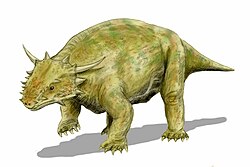Discovery and naming
The Senectosaurus holotype specimen, PIN no. 5864/1, was discovered in 2008 in sediments of the Kutuluk Formation ( Chroniosaurus levis Zone) near Preobrazhenka in the Buzuluksky District of Orenburg Oblast, Russia. The specimen consists of several postcranial associated but disarticulated bones, including 11 osteoderms, a partial right pelvis, the left ilium, a fragmentary right scapula, both ulnae, a tibia and fibula, the left femur, a tarsal, several ribs, and some dorsal vertebrae. An additional specimen, PIN, no. 2895/13, was assigned as a paratype, consisting of an osteoderm from a different locality. [2]
In 2023, Boyarinova & Golubev described Senectosaurus karamzini as a new genus and species of pareiasaur based on these fossil remains. The generic name, "Senectosaurus", is derived from the Latin "senectus", meaning "old", and the Greek "sauros", meaning "lizard". The specific name, "karamzini", honors Nikolai Mikhailovich Karamzin, a Russian historian and writer, as the holotype was discovered near his family estate. [2]
This page is based on this
Wikipedia article Text is available under the
CC BY-SA 4.0 license; additional terms may apply.
Images, videos and audio are available under their respective licenses.

